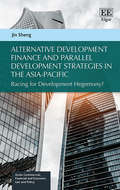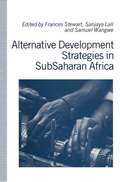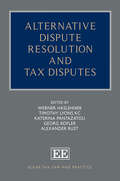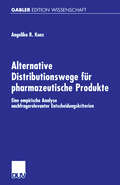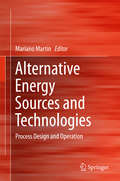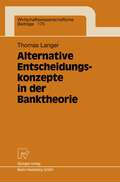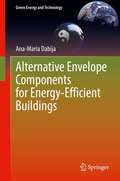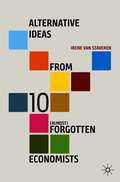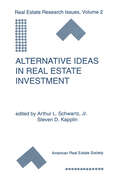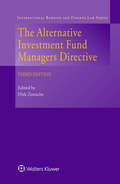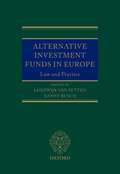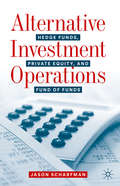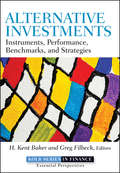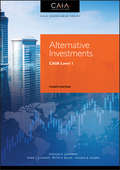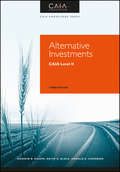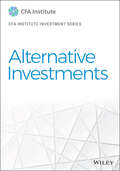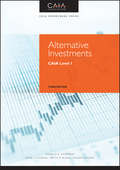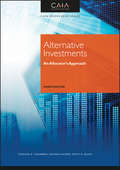- Table View
- List View
Alternative Development Finance and Parallel Development Strategies in the Asia-Pacific: Racing for Development Hegemony? (Asian Commercial, Financial and Economic Law and Policy series)
by Jin ShengThis insightful book examines the impact of two competing visions of Asian-Pacific economic growth paths and development governance. It discusses law, development and finance in the context of the Indo-Pacific Strategy versus the Belt and Road Initiative (BRI), whilst also comparing parallel development financing systems.Jin Sheng reflects on and connects a series of issues of global significance, such as the economic Cold War, global debt, industrialisation and development in the developing world, and the changing international economic order. In so doing the author posits that the BRI’s ultimate objective is to export China’s development model, which is characterised by a focus on exports, experimentalism, and oversupply of currency. The book also critically examines China’s ambition to dominate the international economic order and set up its own favoured international rules.Alternative Development Finance and Parallel Development Strategies in the Asia-Pacific will be an important read for researchers and policy makers in the fields of law, development and finance in the Asia-Pacific region.
Alternative Development Strategies in SubSaharan Africa
by Frances Stewart Sanjaya Lall Samuel M. WangweThe World Bank and the IMF dominate policy-making in Africa today. This book considers the consistency between their adjustment policies and long-run development needs, with an analysis of country experience. An alternative development strategy is proposed.
Alternative Dispute Resolution and Tax Disputes (Elgar Tax Law and Practice series)
Arbitration has been promoted as the future of tax dispute resolution in recent years in line with the increase in complexity of international tax law. This authoritative book presents existing legal rules on the matter, provides a review of the arguments in favour of tax arbitration, discusses the practical and legal challenges for its wide-spread adoption and compatibility with existing domestic and international norms. It also answers key questions for the practical implementation of a modern tax arbitration system.Key Features:Comprehensive analysis of the existing tax treaty framework and their application to MAP and arbitrationUp-to-date guidance on the best practices in alternative dispute resolution to ensure effective and efficient dispute resolutionOriginal insights from dispute resolution mechanisms found in non-tax areas such as trade and investment lawIn-depth discussion of primary and secondary EU law rules on tax dispute resolution, including implications of EU general principles, fundamental rights and internal market rulesIdentifying some of the new issues in tax arbitration and offering views on how to tackle them in the most appropriate way, this book will be a key resource for tax law practitioners looking for the latest insights on how to navigate the legal framework for alternative tax dispute resolution. Students and academics focusing on commercial and tax law will also benefit from this detailed guide.
Alternative Distributionswege für pharmazeutische Produkte: Eine empirische Analyse nachfragerelevanter Entscheidungskriterien
by Angelika KunzAngelika R. Kunz legt eine detaillierte Analyse alternativer Distributionswege aus Nachfragersicht vor. Theoretisch fundiert identifiziert und bewertet sie relevante Einflusskriterien für das Beschaffungsverhalten.
Alternative Energy Sources and Technologies: Process Design and Operation
by Mariano MartínPresenting a comprehensive analysis of the use of alternative sources of energy and technologies to produce fuels and power, this book describes the energy value chain from harvesting the raw material, (i.e solar, wind, biomass or shale gas) followed by analysis of the processing steps into power, fuels and/or chemicals and finally the distribution of the products.Featuring an examination of the techno-economic processes and integration opportunities which can add value to by-products or promote the use of different sources of energy within the same facility, this book looks at the tools that can make this integration possible as well as utilising a real world case study. The case study of the operation of “El hierro” island is used as an example of the current effort towards more efficient use of the resources available. Tackling head on the open challenges of the supply, the variability of the source and its prediction, the description of novel processes that are being developed and evaluated for their transformation as well as how we can distribute them to the consumer and how we can integrate the new chemicals, fuels and power within the current system and infrastructure, the book takes a process based perspective with such an approach able to help us in the use and integration of these sources of energy and novel technologies.
Alternative Entscheidungskonzepte in der Banktheorie (Wirtschaftswissenschaftliche Beiträge #170)
by Thomas LangerDie moderne Banktheorie ist vom Idealbild des Homo Oeconomicus geprägt. Nicht nur die Banken, sondern auch deren Vertragspartner (Kreditnehmer, Privatanleger) werden als rationale Entscheider modelliert. Dieses Vorgehen ignoriert die vielfältigen verhaltenswissenschaftlichen Erkenntnisse über tatsächliches individuelles Entscheidungsverhalten. In der vorliegenden Arbeit wird gezeigt, daß es sinnvoll und möglich ist, alternative Entscheidungskonzepte in banktheoretischen Modellbildungen zu berücksichtigen. Damit wird ein erster Beitrag zu einer verhaltenswissenschaftlich orientierten Banktheorie geliefert. Nach einer umfassenden Übersicht über Phänomene und Anomalien im individuellen Entscheidungsverhalten werden einige konkrete banktheoretische Problemstellungen angesprochen, bei denen diese Erkenntnisse besonders relevant sind.
Alternative Envelope Components for Energy-Efficient Buildings (Green Energy and Technology)
by Ana-Maria DabijaThis book examines ways of saving energy by using green roofs and facades, solar devices such as building-integrated photovoltaics (BIPV), and thermal solar panels, as components of energy-efficient building envelopes. The author takes an interdisciplinary / multidisciplinary approach to the subject that analyzes several different scientific fields connected to building research—sustainability, sustainable architecture, energy efficiency in buildings, and building envelopes—while approaching other collateral domains, including history, archaeology, botanics, physics, engineering, and landscape architecture. Alternative Envelope Components for Energy-Efficient Buildings will be a welcome resource for researchers, students, and postgraduates in the fields of energy, building materials, and renewable energy, as well as architects, engineers, and specialists in industries related to building products.Looks at the impact of building envelopes on energy usage;Offers readers an introduction to the principles of sustainability;Presents passive and active approaches to using solar devices.
Alternative Exchanges: Second-Hand Circulations from the Sixteenth Century to the Present (International Studies in Social History #10)
by Laurence FontaineExchanges have always had more than economic significance: values circulate and encounters become institutionalized. This volume explores the changing meaning of the circulation of second-hand goods from the Renaissance to today, and thereby examines the blurring of boundaries between market, gifts, and charity. It describes the actors of the market - official entities such as corporations, recognized professions, and established markets but also the subterranean circulation that develops around the need for money. The complex layers that not only provide for numerous intermediaries but also include the many men and women who, as sellers or buyers, use these circulations on countless occasions are also examined.
Alternative Food Networks: An Interdisciplinary Assessment
by Alessandro Corsi Filippo Barbera Egidio Dansero Cristiana PeanoIn recent years, Alternative Food Networks (AFNs) have been a key issue both in the scientific community and in public debates. This is due to their profound implications for rural development, local sustainability, and bio-economics. This edited collection discusses what the main determinants of the participation of operators – both consumers and producers – in AFNs are, what the conditions for their sustainability are, what their social and environmental effects are, and how they are distributed geographically. Further discussions include the effect of AFNs in structuring the food chain and how AFNs can be successfully scaled up.The authors explicitly take an interdisciplinary approach to analyse AFNs from different perspectives, using as an example the Italian region of Piedmont, a particularly interesting case study due to the diffusion of AFNs in the area, as well as due to the fact that it was in this region that the ‘Slow Food’ movement originated.
Alternative Ideas from 10 (Almost) Forgotten Economists
by Irene van StaverenHow should we address today’s big problems, and what we can take from icons of economics past? How would John Maynard Keynes have resolved today’s debt problem, or how would Adam Smith have assessed the European carbon emission trading market? This book applies the ideas of ten renowned economists (Marx, Minsky, Keynes, Knight, Bergmann, Veblen, Sen, Myrdal, Smith, Robinson) to real world economic problems, directly or indirectly related to the causes and consequences of the 2008 financial crisis. Each chapter presents an economist, and structures the ‘problem’, the ‘insight’ (the economist’s idea), the ‘economist’ (short bio), and two ‘practices’ offering real-world alternatives. This book presents a lively and original approach that will be of interest to economists and non-economists alike, discussing key elements of an economics for a postcapitalist economy and connecting policy insights to real-world problems of today.
Alternative Ideas in Real Estate Investment (Research Issues in Real Estate #2)
by Arthur L. Schwartz Jr. Steven D. KapplinArthur L. Schwartz, Jr. and Steven D. Kapplin The focus of this volume of the ARES Monograph Series is new ideas in real estate investment. Within this volume, empiricial studies, literature reviews, and tutorials examine a broad range of important investment issues. Many new and innovative ideas are presented. This volume should be a rich source of real estate investment ideas for many years to come. Kapplin and Schwartz examine the returns of two types of REITs, as well as that of Master Limited Partnerships (MLP), over the 1987-1989 time period. Their sample consisted of 54 real estate securities; they conclude that these entities did not provide an effective inflation hedge. MLP returns exceeded that of the overall stock market, but the two REIT types did not provide rates-of-return in excess of the marked. An extensive review of the commercial real estate return literature is presented by Fletcher. He focuses upon studies that utilize commingled real estate fund (CREF) data. His detailed overview of the subject provides a much needed synthesis of the current literature. Roulac presents an extensive discussion of the differences in the per spectives of individual versus institutional investors. In his essay, he considers such factors as scale, diversification, and related issues. Addi tionally, he examines a wide range of literature from within academia, 1 INTRODUCTION 2 as well as the opinions of various real estate gurus. He concludes that behavioral factors override economic considerations.
The Alternative Investment Fund Managers Directive
by Dirk ZetzscheIn the ten years since its coming into force, the Alternative Investment Fund Managers Directive (AIFMD), with almost EUR 7 trillion assets under management in its remit, has become an important piece of European regulation complementing the Undertakings for Collective Investment in Transferable Securities (UCITS) and the Markets in Financial Instruments (MiFI) frameworks. This third edition of the most comprehensive and in-depth analysis of the AIFMD and its related European investment fund legislation (including the European Venture Capital Fund Regulation, the European Social Entrepreneurship Fund Regulation, the European Long-Term Investment Fund Regulation and the European Money Market Fund Regulation among others) brings together fund industry experts, fund supervisors, consultants, lawyers and academics to discuss the content and system of the directive from every angle, including its relation not only to the UCITS and MiFI frameworks but also to pension funds, the Sustainable Finance Disclosure Regulation, the Securitization Regulation and the Cross Border Funds Distribution Directive and Regulation, as well as related pieces of tax regulation at the European level. Further, the third edition emphasizes the function of such factors in the financial services value chain as the following: the AIFMD’s approach to robo-advisors; digital asset funds; infrastructure investments in the context of real estate and sustainable investments; risk management; transparency; and impact on alternative investment strategies. Five country reports, focusing on the European Union’s five most important financial centres for alternative investment funds, deal with the potential interactions among the AIFMD and the relevant laws and regulations of France, Germany, Luxembourg, Ireland and The Netherlands. This thoroughly updated edition elaborates on potential difficulties encountered when applying the directive and provides potential solutions to the problems it raises. The book is sure to be warmly welcomed by fund lawyers and consultants, investors and their counsels, fund managers, depositaries, asset managers and administrators, as well as regulators and academics in the field.
Alternative Investment Funds in Europe (Oxford EU Financial Regulation)
The book provides a full and practical review of the impact of the highly controversial European Directive on Alternative Investment Fund Managers, which was adopted after much debate in October 2010 (AIFMD). The AIFMD is intended to be a regulatory response to systematic risks that came to light in the financial crisis and will have a broad and material impact on the manner in which investment managers may operate and offer non-retail funds (including hedge funds, private equity funds, real estate funds and infrastructure funds), which were previously largely unregulated. The AIFMD not only regulates fund managers based in the EU, but also seeks to regulate non-EU managers who seek to offer non-EU funds to EU investors. Accordingly, the AIFMD will impact all fund offerings to professional investors based in the EU, potentially severely limiting the range of investments available to EU pension funds, insurance companies and other institutional investors. The book begins with a detailed review of the AIFMD itself, including the 'Level 2' rules. The bulk of the book consists of chapters that analyse and explain the national implementation legislation of the EU Member States. Through this structure, the work provides the reader with fast-track access to the regulation at European and national level of non-retail EU and non-EU funds and fund managers, which are caught by the AIFMD.
Alternative Investment Operations: Hedge Funds, Private Equity, and Fund of Funds
by Jason ScharfmanAlternative investments such as hedge funds, private equity, and fund of funds continue to be of strong interest among the investment community. As these investment strategies have become increasingly complex, fund managers have continued to devote more time and resources towards developing best practice operations to support the actual trade processing, fund accounting, and back-office mechanics that allow these strategies to function. Representative of this operational growth, estimates have indicated that fund managers have seen increased operating budgets of 30% or more in recent years.In today’s highly regulated environment, alternative investment managers have also increasingly had to integrate rigorous compliance and cybersecurity oversight into fund operations. Additionally, with recent advances in artificial intelligence and big data analysis, fund managers are devoting larger portions of their information technology budgets towards realizing technology-based operational efficiencies. Alternative investment fund service providers have also substantially increased their scope and breadth of their operations-related services. Furthermore, investors are increasingly performing deep-dive due diligence on fund manager operations at both fund level and management company levels.This book provides current and practical guidance on the foundations of how alternative investment managers build and manage their operations. While other publications have focused on generalized overviews of historical trading procedures across multiple asset classes, and the technical intricacies of specific legacy operational procedures, Alternative Investment Operations will be the first book to focus on explaining up-to-date information on the specific real-world operational practices actually employed by alternative investment managers. This book will focus on how to actually establish and manage fund operations. Alternative Investment Operations will be an invaluable up-to-date resource for fund managers and their operations personnel as well as investors and service providers on the implementation and management of best practice operations.
Alternative Investments: Instruments, Performance, Benchmarks, and Strategies (Robert W. Kolb Series #609)
by H. Kent Baker Greg FilbeckA comprehensive guide to alternative investments that reveals today's latest research and strategies Historically low interest rates and bear markets in world stock markets have generated intense interest in alternative investments. With returns in traditional investment vehicles relatively low, many professional investors view alternative investments as a means of meeting their return objectives. Alternative Investments: Instruments, Performance, Benchmarks, and Strategies, can put you in a better position to achieve this difficult goal. Part of the Robert W. Kolb Series in Finance, Alternative Investments provides an in-depth discussion of the historic performance, benchmarks, and strategies of every major alternative investment market. With contributions from professionals and academics around the world, it offers valuable insights on the latest trends, research, and thinking in each major area. Empirical evidence about each type of alternative investment is featured, with research presented in a straightforward manner. Examines a variety of major alternative asset classes, from real estate, private equity, and commodities to managed futures, hedge funds, and distressed securities Provides detailed insights on the latest research and strategies, and offers a thorough explanation of historical performance, benchmarks, and other critical information Blends knowledge from the conceptual world of scholars with the pragmatic view of practitioners in this field Alternative investments provide a means of diversification, risk control, and return enhancement and, as such, are attractive to many professional investors. If you're looking for an effective way to hone your skills in this dynamic area of finance, look no further than this book.
Alternative Investments: Instruments, Performance, Benchmarks, and Strategies (Robert W. Kolb Series #608)
by H. Kent Baker Greg FilbeckA comprehensive guide to alternative investments that reveals today's latest research and strategies Historically low interest rates and bear markets in world stock markets have generated intense interest in alternative investments. With returns in traditional investment vehicles relatively low, many professional investors view alternative investments as a means of meeting their return objectives. Alternative Investments: Instruments, Performance, Benchmarks, and Strategies, can put you in a better position to achieve this difficult goal. Part of the Robert W. Kolb Series in Finance, Alternative Investments provides an in-depth discussion of the historic performance, benchmarks, and strategies of every major alternative investment market. With contributions from professionals and academics around the world, it offers valuable insights on the latest trends, research, and thinking in each major area. Empirical evidence about each type of alternative investment is featured, with research presented in a straightforward manner. Examines a variety of major alternative asset classes, from real estate, private equity, and commodities to managed futures, hedge funds, and distressed securities Provides detailed insights on the latest research and strategies, and offers a thorough explanation of historical performance, benchmarks, and other critical information Blends knowledge from the conceptual world of scholars with the pragmatic view of practitioners in this field Alternative investments provide a means of diversification, risk control, and return enhancement and, as such, are attractive to many professional investors. If you're looking for an effective way to hone your skills in this dynamic area of finance, look no further than this book.
Alternative Investments: CAIA Level I (Wiley Finance)
by Keith Black CAIA Association Hossein Kazemi Donald Chambers Mark AnsonAlternative Investments: CAIA Level I, 4th Edition is the curriculum book for the Chartered Alternative Investment Analyst (CAIA) Level I professional examination. Covering the fundamentals of the alternative investment space, this book helps you build a foundation in alternative investment markets. You'll look closely at the different types of hedge fund strategies and the range of statistics used to define investment performance as you gain a deep familiarity with alternative investment terms and develop the computational ability to solve investment problems. From strategy characteristics to portfolio management strategies, this book contains the core material you will need to succeed on the CAIA Level I exam. This updated fourth edition tracks to the latest version of the exam and is accompanied by the following ancillaries: a workbook, study guide, learning objectives, and an ethics handbook.
Alternative Investments: CAIA Level I (Wiley Finance)
by CAIA Association Mark J. Anson Keith H. Black Donald R. Chambers Hossein B. KazemiAlternative Investments: CAIA Level I, 4th Edition is the curriculum book for the Chartered Alternative Investment Analyst (CAIA) Level I professional examination. Covering the fundamentals of the alternative investment space, this book helps you build a foundation in alternative investment markets. You'll look closely at the different types of hedge fund strategies and the range of statistics used to define investment performance as you gain a deep familiarity with alternative investment terms and develop the computational ability to solve investment problems. From strategy characteristics to portfolio management strategies, this book contains the core material you will need to succeed on the CAIA Level I exam. This updated fourth edition tracks to the latest version of the exam and is accompanied by the following ancillaries: a workbook, study guide, learning objectives, and an ethics handbook.
Alternative Investments: CAIA Level II
by CAIA Association Hossein Kazemi Keith H. Black Donald R. ChambersIn-depth Level II exam preparation direct from the CAIA Association CAIA Level II is the official study guide for the Chartered Alternative Investment Analyst professional examination, and an authoritative guide to working in the alternative investment sphere. Written by the makers of the exam, this book provides in-depth guidance through the entire exam agenda; the Level II strategies are the same as Level I, but this time you'll review them through the lens of risk management and portfolio optimisation. Topics include asset allocation and portfolio oversight, style analysis, risk management, alternative asset securitisation, secondary market creation, performance and style attribution and indexing and benchmarking, with clear organisation and a logical progression that allows you to customise your preparation focus. This new third edition has been updated to align with the latest exam, and to reflect the current practices in the field. The CAIA designation was developed to provide a standardized knowledge base in the midst of explosive capital inflow into alternative investments. This book provides a single-source repository of that essential information, tailored to those preparing for the Level II exam. Measure, monitor and manage funds from a risk management perspective Delve into advanced portfolio structures and optimisation strategies Master the nuances of private equity, real assets, commodities and hedge funds Gain expert insight into preparing thoroughly for the CAIA Level II exam The CAIA Charter programme is rigorous and comprehensive, and the designation is globally recognised as the highest standard in alternative investment education. Candidates seeking thorough preparation and detailed explanations of all aspects of alternative investment need look no further than CAIA Level II.
Alternative Investments: CAIA Level II
by CAIA Association Hossein Kazemi Keith H. Black Donald R. ChambersIn-depth Level II exam preparation direct from the CAIA Association CAIA Level II is the official study guide for the Chartered Alternative Investment Analyst professional examination, and an authoritative guide to working in the alternative investment sphere. Written by the makers of the exam, this book provides in-depth guidance through the entire exam agenda; the Level II strategies are the same as Level I, but this time you'll review them through the lens of risk management and portfolio optimisation. Topics include asset allocation and portfolio oversight, style analysis, risk management, alternative asset securitisation, secondary market creation, performance and style attribution and indexing and benchmarking, with clear organisation and a logical progression that allows you to customise your preparation focus. This new third edition has been updated to align with the latest exam, and to reflect the current practices in the field. The CAIA designation was developed to provide a standardized knowledge base in the midst of explosive capital inflow into alternative investments. This book provides a single-source repository of that essential information, tailored to those preparing for the Level II exam. Measure, monitor and manage funds from a risk management perspective Delve into advanced portfolio structures and optimisation strategies Master the nuances of private equity, real assets, commodities and hedge funds Gain expert insight into preparing thoroughly for the CAIA Level II exam The CAIA Charter programme is rigorous and comprehensive, and the designation is globally recognised as the highest standard in alternative investment education. Candidates seeking thorough preparation and detailed explanations of all aspects of alternative investment need look no further than CAIA Level II.
Alternative Investments (CFA Institute Investment Series)
by CFA InstituteThe complete guide to alternative investments, from experts working with CFA Institute Alternative Investments is the definitive guide to understanding non-traditional asset classes. Alternatives are a disparate group of investments that are distinguished from long-only, publicly traded investments in stocks, bonds, and cash (often referred to as traditional investments). Alternative investments include real estate, commodities, infrastructure, and other non-traditional investments such as private equity or debt and hedge funds. They are attractive to investors because of the potential for portfolio diversification resulting in a higher risk-adjusted return for the portfolio. Alternative Investments and its accompanying workbook (sold separately) lead students and investment professionals through the many characteristics of non-traditional assets, including: Narrow specialization of the investment managers Relatively low correlation of returns with those of traditional investments Less regulation and less transparency than traditional investments Limited historical risk and return data Unique legal and tax considerations Higher fees, often including performance or incentive fees Concentrated portfolios Restrictions on redemptions (i.e. “lockups” and “gates”) CFA Institute is the world's premier association for investment professionals, and the governing body for the CFA® Program, CIPM® Program, CFA Institute ESG Investing Certificate, and Investment Foundations® Program. Those seeking a deeper understanding of the markets, mechanisms, and use of alternatives will value the level of expertise CFA Institute brings to the discussion, providing a clear, comprehensive resource for students and professionals alike. Whether used alone or in conjunction with the companion workbook, Alternative Investments offers a complete course in alternative investments and their role in investment management.
Alternative Investments (CFA Institute Investment Series)
by CFA InstituteThe complete guide to alternative investments, from experts working with CFA Institute Alternative Investments is the definitive guide to understanding non-traditional asset classes. Alternatives are a disparate group of investments that are distinguished from long-only, publicly traded investments in stocks, bonds, and cash (often referred to as traditional investments). Alternative investments include real estate, commodities, infrastructure, and other non-traditional investments such as private equity or debt and hedge funds. They are attractive to investors because of the potential for portfolio diversification resulting in a higher risk-adjusted return for the portfolio. Alternative Investments and its accompanying workbook (sold separately) lead students and investment professionals through the many characteristics of non-traditional assets, including: Narrow specialization of the investment managers Relatively low correlation of returns with those of traditional investments Less regulation and less transparency than traditional investments Limited historical risk and return data Unique legal and tax considerations Higher fees, often including performance or incentive fees Concentrated portfolios Restrictions on redemptions (i.e. “lockups” and “gates”) CFA Institute is the world's premier association for investment professionals, and the governing body for the CFA® Program, CIPM® Program, CFA Institute ESG Investing Certificate, and Investment Foundations® Program. Those seeking a deeper understanding of the markets, mechanisms, and use of alternatives will value the level of expertise CFA Institute brings to the discussion, providing a clear, comprehensive resource for students and professionals alike. Whether used alone or in conjunction with the companion workbook, Alternative Investments offers a complete course in alternative investments and their role in investment management.
Alternative Investments: CAIA Level I (Wiley Finance #194)
by Donald R. Chambers Mark J. Anson Keith H. Black Hossein Kazemi CAIA AssociationThe official CAIA Level 1 curriculum bookAlternative Investments: CAIA Level I, 3rd Edition is the curriculum book for the Chartered Alternative Investment Analyst (CAIA) Level I professional examination. Covering the fundamentals of the alternative investment space, this book helps you build a foundation in alternative investment markets. You'll look closely at the different types of hedge fund strategies and the range of statistics used to define investment performance as you gain a deep familiarity with alternative investment terms and develop the computational ability to solve investment problems. From strategy characteristics to portfolio management strategies, this book contains the core material you will need to succeed on the CAIA Level I exam. This updated third edition tracks to the latest version of the exam, and is accompanied by the following ancillaries: a workbook, study guide, learning objectives, and an ethics handbook. Most investment analyst education programs focus primarily on the traditional asset classes, pushing alternative investments to the sidelines. The CAIA designation was developed in response to the tremendous growth of alternative investing, and is the industry's premier educational standard. This book is your official study companion, bringing you fully up to speed on everything you need to know (with the exception of the ethics material covered in a separate handbook). Understand the complexities of each alternative asset class Learn the quantitative techniques professionals use every day Dig into the unique aspects of alternative investments Master the core material covered by the CAIA Level I exam More than 300 financial institutions and hedge funds have committed key executives to the CAIA exam, and this rapidly growing trend speaks to the designation's rising status as a must-have credential for anyone in the alternative investment sphere. Increase your chances of success by getting your information straight from the source in CAIA Level I.
Alternative Investments: CAIA Level I (Wiley Finance)
by Donald R. Chambers Mark J. Anson Keith H. Black Hossein Kazemi CAIA AssociationThe official CAIA Level 1 curriculum bookAlternative Investments: CAIA Level I, 3rd Edition is the curriculum book for the Chartered Alternative Investment Analyst (CAIA) Level I professional examination. Covering the fundamentals of the alternative investment space, this book helps you build a foundation in alternative investment markets. You'll look closely at the different types of hedge fund strategies and the range of statistics used to define investment performance as you gain a deep familiarity with alternative investment terms and develop the computational ability to solve investment problems. From strategy characteristics to portfolio management strategies, this book contains the core material you will need to succeed on the CAIA Level I exam. This updated third edition tracks to the latest version of the exam, and is accompanied by the following ancillaries: a workbook, study guide, learning objectives, and an ethics handbook. Most investment analyst education programs focus primarily on the traditional asset classes, pushing alternative investments to the sidelines. The CAIA designation was developed in response to the tremendous growth of alternative investing, and is the industry's premier educational standard. This book is your official study companion, bringing you fully up to speed on everything you need to know (with the exception of the ethics material covered in a separate handbook). Understand the complexities of each alternative asset class Learn the quantitative techniques professionals use every day Dig into the unique aspects of alternative investments Master the core material covered by the CAIA Level I exam More than 300 financial institutions and hedge funds have committed key executives to the CAIA exam, and this rapidly growing trend speaks to the designation's rising status as a must-have credential for anyone in the alternative investment sphere. Increase your chances of success by getting your information straight from the source in CAIA Level I.
Alternative Investments: An Allocator's Approach (Wiley Finance Ser.)
by Donald R. Chambers Hossein B. Kazemi Keith H. Black CAIA AssociationWhether you are a seasoned professional looking to explore new areas within the alternative investment arena or a new industry participant seeking to establish a solid understanding of alternative investments, Alternative Investments: An Allocator's Approach, Fourth Edition (CAIA Level II curriculum official text) is the best way to achieve these goals. In recent years, capital formation has shifted dramatically away from public markets as issuers pursue better financial and value alignment with ownership, less onerous and expensive regulatory requirements, market and information dislocation, and liberation from the short-term challenges that undergird the public capital markets. The careful and informed use of alternative investments in a diversified portfolio can reduce risk, lower volatility, and improve returns over the long-term, enhancing investors' ability to meet their investment outcomes. Alternative Investments: An Allocator's Approach (CAIA Level II curriculum official text) is a key resource that can be used to improve the sophistication of asset owners and those who work with them. This text comprises the curriculum, when combined with supplemental materials available at caia.org, for the CAIA Level II exam. "Over the course of my long career one tenet has held true, 'Continuing Education'. Since CalSTRS is a teachers' pension plan, it is no surprise that continuing education is a core attribute of our Investment Office culture. Overseeing one of the largest institutional pools of capital in the world requires a cohesive knowledge and understanding of both public and private market investments and strategies. We must understand how these opportunities might contribute to delivering on investment outcomes for our beneficiaries. Alternative Investments: An Allocator's Approach is the definitive core instruction manual for an institutional investor, and it puts you in the captain's chair of the asset owner."—Christopher J. Ailman, Chief Investment Officer, California State Teachers’ Retirement System "Given their diversified cash flow streams and returns, private markets continue to be a growing fixture of patient, long-term portfolios. As such, the need to have proficiency across these sophisticated strategies, asset classes, and instruments is critical for today's capital allocator. As a proud CAIA charterholder, I have seen the practical benefits in building a strong private markets foundation, allowing me to better assist my clients."—Jayne Bok, CAIA, CFA, Head of Investments, Asia, Willis Tower Watson
